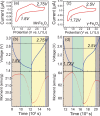Reversible control of the magnetization of spinel ferrites based electrodes by lithium-ion migration
- PMID: 28970542
- PMCID: PMC5624968
- DOI: 10.1038/s41598-017-12948-6
Reversible control of the magnetization of spinel ferrites based electrodes by lithium-ion migration
Abstract
Lithium-ion (Li-ion) batteries based on spinel transition-metal oxide electrodes have exhibited excellent electrochemical performance. The reversible intercalation/deintercalation of Li-ions in spinel materials enables not only energy storage but also nondestructive control of the electrodes' physical properties. This feature will benefit the fabrication of novel Li-ion controlled electronic devices. In this work, reversible control of ferromagnetism was realized by the guided motion of Li-ions in MnFe2O4 and γ-Fe2O3 utilizing miniature lithium-battery devices. The in-situ characterization of magnetization during the Li-ion intercalation/deintercalation process was conducted, and a reversible variation of saturation magnetization over 10% was observed in both these materials. The experimental conditions and material parameters for the control of the ferromagnetism are investigated, and the mechanism related to the magnetic ions' migration and the exchange coupling evolution during this process was proposed. The different valence states of tetrahedral metal ions were suggested to be responsible for the different performance of these two spinel materials.
Conflict of interest statement
The authors declare that they have no competing interests.
Figures






Similar articles
-
Design Strategies of Spinel Oxide Frameworks Enabling Reversible Mg-Ion Intercalation.Acc Chem Res. 2024 Jan 2;57(1):1-9. doi: 10.1021/acs.accounts.3c00282. Epub 2023 Dec 19. Acc Chem Res. 2024. PMID: 38113116
-
In Situ Investigation of Li and Na Ion Transport with Single Nanowire Electrochemical Devices.Nano Lett. 2015 Jun 10;15(6):3879-84. doi: 10.1021/acs.nanolett.5b00705. Epub 2015 May 26. Nano Lett. 2015. PMID: 25989463
-
Formation of the spinel phase in the layered composite cathode used in Li-ion batteries.ACS Nano. 2013 Jan 22;7(1):760-7. doi: 10.1021/nn305065u. Epub 2012 Dec 18. ACS Nano. 2013. PMID: 23237664
-
Lithium versus Mono/Polyvalent Ion Intercalation: Hybrid Metal Ion Systems for Energy Storage.Chem Rec. 2019 Feb;19(2-3):474-501. doi: 10.1002/tcr.201800081. Epub 2018 Aug 17. Chem Rec. 2019. PMID: 30117651 Review.
-
Chemistry-mechanics-geometry coupling in positive electrode materials: a scale-bridging perspective for mitigating degradation in lithium-ion batteries through materials design.Chem Sci. 2022 Dec 8;14(3):458-484. doi: 10.1039/d2sc04157j. eCollection 2023 Jan 18. Chem Sci. 2022. PMID: 36741524 Free PMC article. Review.
Cited by
-
Magnetically active lithium-ion batteries towards battery performance improvement.iScience. 2021 Jun 17;24(6):102691. doi: 10.1016/j.isci.2021.102691. eCollection 2021 Jun 25. iScience. 2021. PMID: 34466780 Free PMC article. Review.
-
Evidence of a cubic iron sub-lattice in t-CuFe2O4 demonstrated by X-ray Absorption Fine Structure.Sci Rep. 2018 Jan 15;8(1):797. doi: 10.1038/s41598-017-19045-8. Sci Rep. 2018. PMID: 29335500 Free PMC article.
References
-
- Yin J, et al. Graphene-wrapped single-crystalline Fe3O4 nanorods with superior lithium-storage capabilities. New J.Chem. 2014;38:4036. doi: 10.1039/C4NJ00767K. - DOI
Publication types
LinkOut - more resources
Full Text Sources
Other Literature Sources

